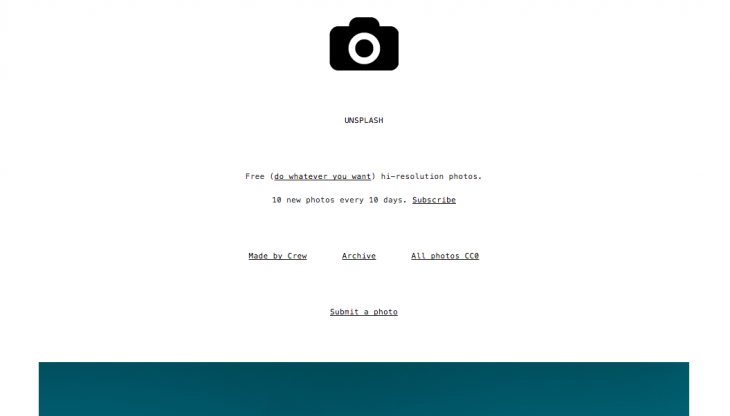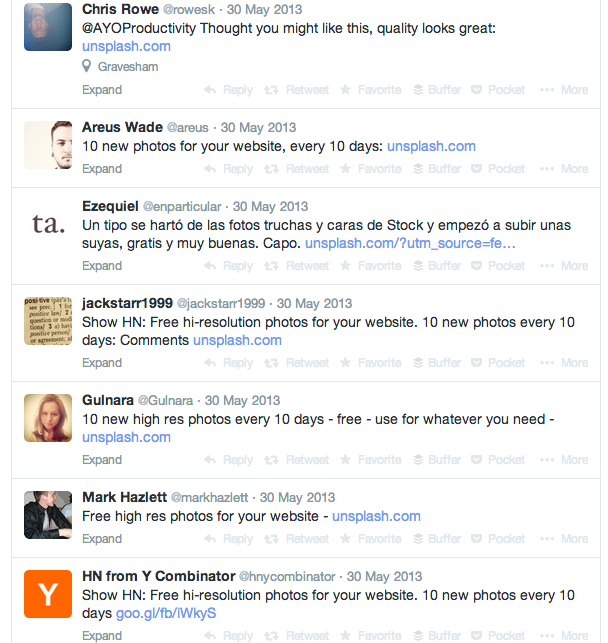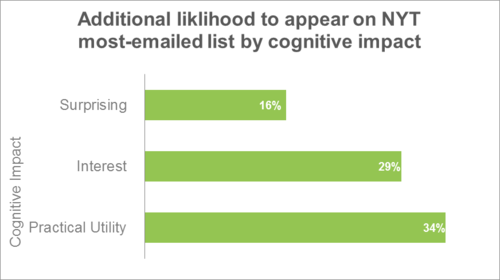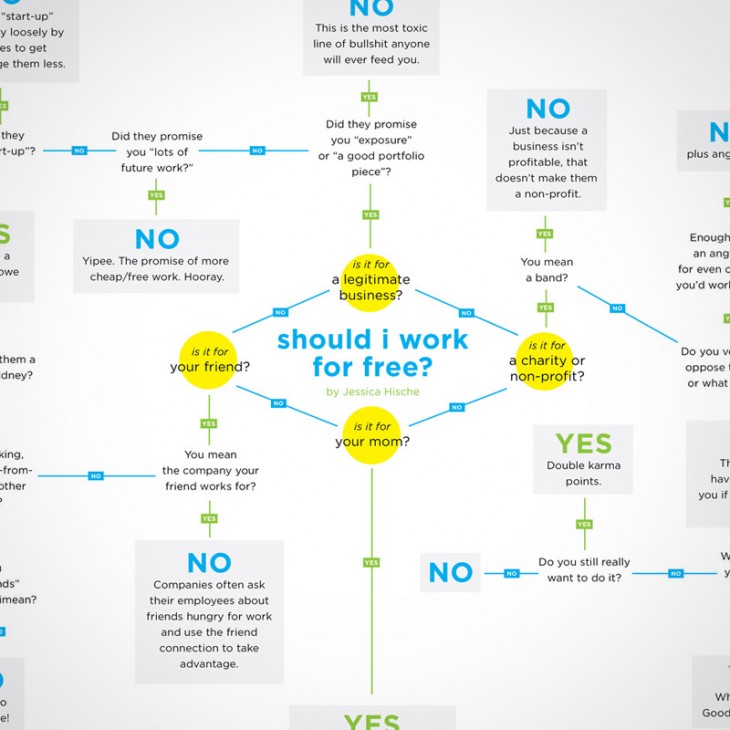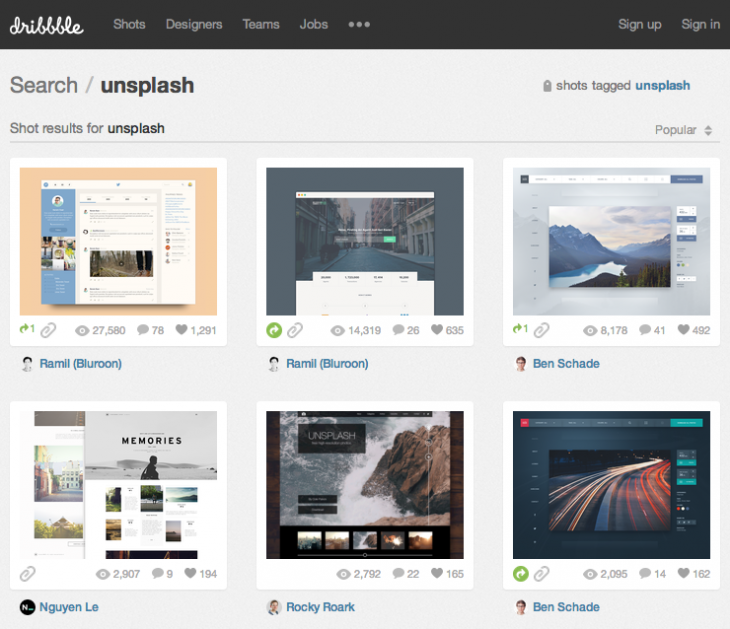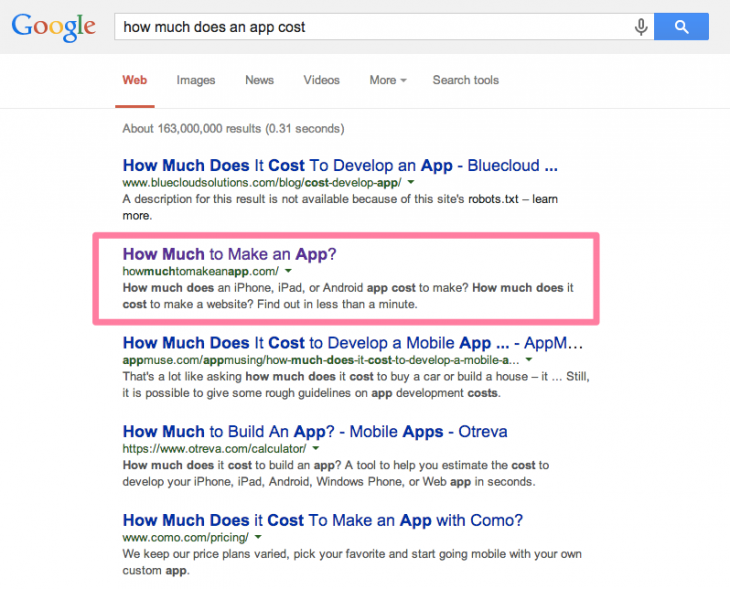
Mikael Cho is the co-founder of Crew, a network that connects short-term software projects with handpicked developers and designers. This post originally appeared on the Crew blog.
We had no money.
We changed our business model and had three months worth of cash left to turn things around. If we didn’t we were toast. Done.
We needed to find customers. But no one knew who we were.
A marketing budget? Please. We were just trying to keep the lights on.
This was our situation a year and half ago at Crew. We knew we had to grow but we didn’t know how we were going to do it in a substantial way.
Things like blogging work but can take months before they have a big impact. Building a great product to generate word-of-mouth is a must but that takes time too.
Even though we were working on these things, we needed to find a way to accelerate “normal” growth if we were going to survive.
Around this time, we were creating the homepage of our website. While searching for a photo to use, we noticed every photography option was either too crappy, too expensive, or both.
Instead, we hired a photographer and took a bunch of photos at a coffee shop. We only used one photo so we had extras. We thought, there’s probably a bunch of people having the same issue as us so let’s post these photos online and give them away for free.
A $19 Tumblr theme and three hours later, we had a site called Unsplash, with 10 of our best extra photos and a link back to our homepage.
Here’s a screenshot of an early version of Unsplash:
We put unsplash.com live and shared the link on HackerNews – a website that lists the best things found on the internet and allows members to vote on the submissions. The HackerNews community is largely made up of designers, programmers and entrepreneurs – an audience we thought might find Unsplash useful.
What happened next floored me.
Apart from maybe a few hundred visitors to the site, I didn’t think much would come from posting the link to HackerNews. I moved on with my day until I got an email from the photographer who took the photos. He wrote,
“Dude, happy you enjoyed the photos! I don’t know what you did with them but there’s a ton of people on my portfolio site right now!”
I went back to HackerNews to check what might be going on.
Unsplash was featured as the number one site.
Here’s an image of the original submission and comment thread on HackerNews:
People visiting Unsplash came pouring in.
20,000 visitors.
10 minutes later, it was 50,000 visitors.
We then saw a huge spike in traffic to our homepage for Crew. A large number of customers came. And a whole lot of love. Substantially more than we ever got from any ad campaign or blog post. Here’s a shot of the tweets that came through the first moments Unsplash was live.
This all came from something that took less than an afternoon to create.
It seemed like magic. How could this happen? More people cared about us in a few hours than in the entire last year. We made Unsplash to give something valuable to people. We thought even if a few hundred people find it useful, that’d be a win. But we didn’t expect it could have this level of impact.
That day, we not only experienced the immediate benefits of creating value but also a much bigger shift in how marketing needs to be done today in order to be heard.
The best marketing is when you don’t know it’s marketing
I hate when I know I’m being sold to. I tune out. And so does everyone else.
It’s not good enough to hammer your marketing message down people’s throats and expect them buy. This is especially the case today. As bestselling author Jay Bauer wrote in his book Youtility:
“Due to enormous shifts in technology and consumer behavior, customers want a new approach that cuts through the clutter: marketing that is truly, inherently useful.”
Networks like Facebook, Twitter and Instagram feed in content at a high volume. Multiple devices for home, for work, and everything in between allows this stream of content to seep into every aspect of our daily lives. Your company messages are mixed in with photos and updates from friends and family.
You are no longer just competing with other companies for attention, you’re competing with the people closest to your customers, notes Jay. In order to cut through this noise, Jay states that you must create “marketing so useful, people would pay for it.”
This doesn’t mean you need to charge people for access to your marketing. It means that your marketing should be so good that people would gladly pay for it if they were asked.
To have customers and fans, you need to create value first. In today’s world, this is often much more value than you think. When you create value first, people pay attention.
This is exactly what two University of Pennsylvania professors found when they looked at the New York Times most emailed articles.
The results of their study showed that people liked sharing stories that taught them something the most – even more than stories that might be surprising and interesting:
Giving someone something useful they can apply to their own lives has the biggest impact. After I read this research, I wondered, “If a story with practical value could have this level of impact, what would happen if this practical utility could be applied to something even more useful than a blog post?”
Side projects as marketing
Side projects get a bad rep. Businesses question:
- “Do they make us look distracted?”
- “We’re already so busy, are they worth the time to do?”
To shift this thinking, we need to reconsider what is defined as a “side project.” Calling something a side project implies it’s being done on the side and not part of your main focus. But if you’re doing a project to create value for your company, then this is no different than working on any other value-creating project like your blog.
Just because a project might be a website or app where code needs to be written, we tend to label it side project if it’s not the core product. This isn’t always true.
A website or app might just be an advanced form of marketing. We shouldn’t be too quick to classify something as an unrelated side project without understanding its purpose.
In the freelance world, many professionals work with clients and have their own independent projects; oftentimes, to help build their personal brand.
Designer Jessica Hische has now worked with notable companies like MailChimp and Pinterest. But when she started, she needed to find her first clients just like everyone else. To stand out, Jessica started working on side projects early on in her career. Apart from being interesting and valuable, these side projects also showed Jessica’s skills as an illustrator.
As Jessica mentions on her portfolio site:
“The first (side project), was pure eye candy and helped jump start my lettering career. Since then I’ve used side projects to exercise parts of my brain that go unused during client time, and have had a blast creating fun resources for other designers.”
Jessica became well-known for her side projects like this one called “Should I work for free?”
Apart from the quality of her work, these side projects helped Jessica accelerate her exposure in the design community and attract clients.
Similarly, when no one knew about our company Crew, we needed to find a way to quickly meet customers. Because we are a technology startup, andstartups are largely defined by growth, we needed to find ways to grow faster than a normal rate.
Building tools was one way we thought we could do this.
The ROI of side projects
The psychological benefits of side projects, like improved collaboration and better ideas, have been documented. It’s one the reasons why Google created the 20 percent time for employees to work on whatever they want.
But there’s also a measurable impact from side projects. In the past year and a half since we started Crew, we made four projects that are separate from our Crew domain.
Here’s how they’ve done:
Unsplash
Unsplash is website that offers 10 free (do whatever you want) hi-res photos, every ten days.
Results:
- 5 million unique visitors
- #1 referral source to Crew
A key part of our member base at Crew is mobile and Web designers and developers. Many that have signed up for Crew have come directly from Unsplash. These designers and developers also use many of the Unsplash photos in their work. Here’s a feed of some of what’s being made with Unsplash:
Launch This Year
Launch This Year is a collection of weekly lessons on how to build a business, handpicked by Web industry professionals like Naval Ravikant, Founder of AngelList and Hiten Shan, Founder of KISSmetrics.
Results:
- Covered by VentureBeat, Digital Trends, Lifehacker, and Tech Vibes
- 20,000+ email subscribers
How Much To Make An App
How Much To Make An App is a website that helps you estimate the cost of your app idea in less than a minute.
Results:
- 1 million unique visitors
- #2 referral source to Crew
- 25 percent of Crew project submissions
Moodboard
Moodboard is website that allows you to share your website design ideas with a link. No account needed.
Results:
- #5 referral source to Crew
Overall Results from side projects:
- 3 of the top 5 referring sites to Crew
- 100,000+ email subscribers
- 40 percent of our Revenue
Side projects: More efficient than blogging
If we compare the data from these projects to our blog, they’ve been more efficient for building an audience.
Blog
- #3 referral source to Crew
- 50,000 unique visitors/month
- 3,600+ email subscribers
Although our blog does well and is the #3 referral source to Crew, it took us over a year and 85 posts to get to this level. The projects above have generated more than 25 times the number of subscribers with less time investment.
Creating a tool often requires less time than writing blog posts but can have a much bigger impact. When you need to grow fast, you’re looking for impact.
Granted, writing is important for more than just bringing in new customers and email subscribers. It’s also about building trust and a connection with the people who might use your product someday.
But making a tool has the same effect, just at an accelerated rate.
Side projects have a longer shelf life
It’s more likely you’ll use a good product many times than read a good blog post many times.
This repeated usefulness is what makes software products so valuable. When you create an app or website as marketing, you’re able to extract the value that exists in software and apply it to marketing. People keep coming back even though you’re not putting in extra work.
This is what happens with many of our projects. Here’s a look at the repeat visitors to Unsplash in the past month. Over half the visitors have already visited the site before.
With a blog, you need to continually produce content at a high level and high rate to keep people coming back. This is possible it just takes longer.
We still write on our blog but if we feel we can go a step further than a blog post, we think, “Is there something else we could make instead of a blog or in addition to one that would be even more helpful?”
Next: Additional benefits, plus how to do side projects the right way
4 other benefits of side projects
1. Hiring
We didn’t expect these projects could help with hiring but we noticed that many applicants came after seeing one of the tools we created.
We get 50 applicants a week from Unsplash alone. Almost half the current Crew team said they found us and applied because they saw one of our projects.
We also noticed that we tend to attract the type of people who align with our belief of creating value as the best form of marketing. These are the people we want on our team.
2. Inspires a “level up” mentality
When we see the value these projects create, this inspires ideas for how we can do things differently across all the other parts of our company. How can we take customer support or our hiring process to another level?
Just as marketing has evolved, other areas of building a business are changing too. Seeing the impact of side projects on marketing encourages a mentality to think about how can we do things differently, not just follow what other people have done because it has worked in the past.
3. Test without confusing your offering
Many of our side projects are potential features that we’re considering building into Crew. By putting them on a separate website, it allows us to test these features without diluting our core offering.
4. More opportunities for press/search traffic
If you build your tool on a separate website, what you sacrifice in not having on your domain, you gain in exposure and memorability.
There’s more opportunities for press coverage and to be featured on product discovery websites like HackerNews or Product Hunt.
People remember the project name Unsplash, or search for keywords like, “How much does an app cost?” rather than having to remember a domain like free-photos.pickcrew.com or howmuchtomakeanapp.pickcrew.com.
Because it’s easier to remember the name, repeat usage can be higher and word-of-mouth can spread faster. You can find a way to link back to your domain to get the referral traffic. Usually we start with a link that says “Made by Crew.” This often does the trick for us.
Because of the amount traffic, tools are also great for winning search engine keyword terms you’re after. With the right tool you can outrank a blog post and make it to the first page of search results quicker.
That’s exactly what happened with How Much To Make An App. It only took a few weeks before it was ranked in the first page on Google for the competitive keyword phrase, “How much does an app cost”
How to do a side project the right way
Not every idea is a good fit to be a project worth your time. When we have an idea for a project here’s the criteria we look for before we decide to put any work into it:
1. Small scope
The tool must be small in size (usually one to two pages). When I first showed one of our investors, Fred Destin, the tools we created, he said, “They’re like landing pages on steroids.”
That’s exactly what they are. With a side project, the best approach is to keep it simple. Solve a problem in a much simpler way than anyone else.
Reduce features to the minimum. Don’t worry about accounts. Don’t even worry about code if you don’t have to. Unsplash was made without writing a line of code. Simple will be your edge.
2. Minimal updates
Because your side project will be small in scope, you also reduce the need for maintenance and updates.
Your aim should be to get the project working so it either needs no future updates or it needs very little to provide continuous value.
We only update one of our projects if it’s doing exceptionally well and the update has the potential to make it much better. “Exceptionally well” to us usually means the project is a top 5 referral source.
If you’re going to update one of your marketing projects, ask yourself, “Will improving this existing project be more valuable than building a new one?”
When we built How Much To Make An App for instance, we released it and did very little with it after. Only when we saw the value it was creating did we decide to make improvements that could have a big impact.
If you release a project and it doesn’t resonate with your audience, leave it and move on to something else. Don’t take more time trying to make it better. It’s usually more efficient to try something different.
Marketing today is defined by how useful it is to your customers. And the bar for useful has risen substantially. Where blog posts, infographics, and webinars were once marketing gold, websites, apps, and tools are taking over.
Don’t be trapped into thinking you have to follow what everyone else is doing because it’s supposed to work. If you follow, expect similar results. Nothing more.
To make a substantial impact in how your company is growing, you must create extreme value. This is the only knife that can cut through the clutter of today.
Read next: Does your to-do list make you sad? Here’s how to change that
Get the TNW newsletter
Get the most important tech news in your inbox each week.
